![]()
AN EXHIBITION BY CHEN XI
This is an art exhibition shown in the Chinese artist Chen Xi’s So we remember series which include both her oil paintings and watercolours. We will discuss the role of watercolour as a sketch in preparation for this series, and we also study how watercolour is used as a primary medium and a medium for before- and afterthoughts.
The exhibition expresses the huge changes that the Chinese artist has experienced in her life so far, and the unease that she feels about the fast changes taking place at present, as well as a societies acceptant of the controlled and convenient access to information obtained by the television network.
The exhibition was held at the University Museum and Art Gallery of the University of Hong Kong in the spring 2016. The director Florian Knothe wrote in the introduction: “The paintings illustrate important events that have shaped our modern world. The artist created this series of contemporary images to commemorate, to document and to provoke thoughts.
In the current show, we present her preliminary pen and watercolour drawings along with the finished oil paintings”. He continuous: “By presenting the paintings within the TV’s glass, they become screen shots linked to a specific moment in time and space, as well as to the living room setting where the news would have been seen”.
I would like to illustrate this as a very efficient way of telling history supported with information about the people at a certain time in a given context:
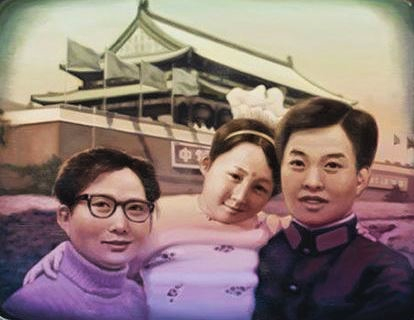
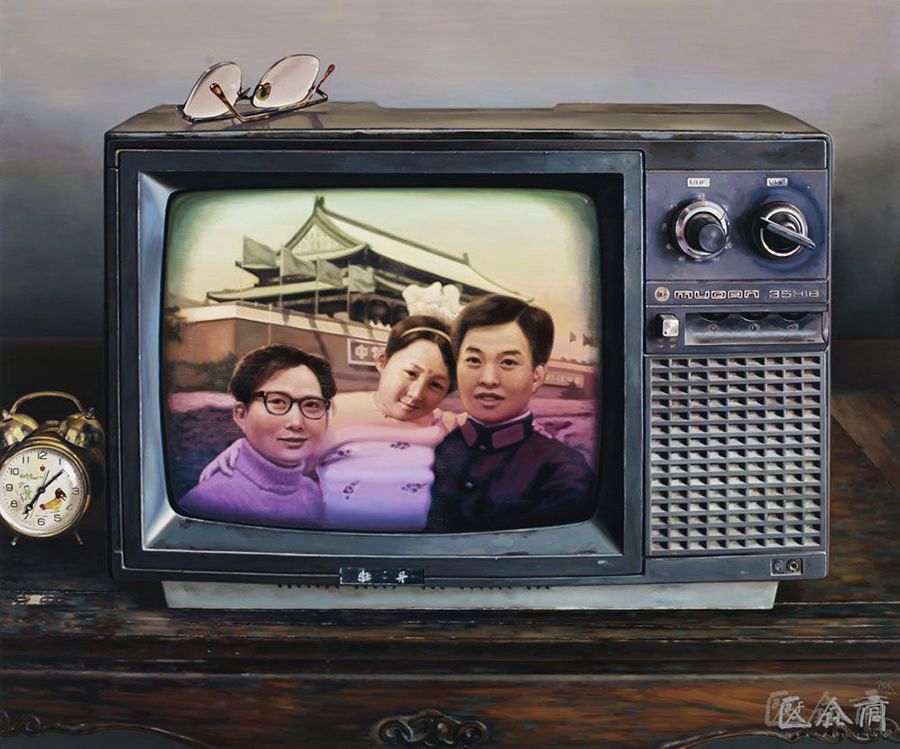
A section of the painting and the whole painting:
“One – child policy”, Oil on canvas, 150 x 180 cm, 2010
As seen, a single realistic painting could show a government’s introduction of a strategy as: the one - child policy, but the painting to the right showed it all. It shows the wealth of the people looking on the TV. It shows the years it took place by depicting a specific TV set and it shows the taste of the people illustrated by typical items as the alarm clock and design of glasses in the above painting.
The exhibition gives 22 different examples on important Chinese events taking place during the years and it is examples where TV has a key role of shaping the events and some of them may even be a sort of TV produced incidents. It goes from the gang of four trial in court, Chairman Mao’s memorial ceremony, military parades, Tangshan earthquake to different happy events as opening ceremony of the Olympic Games and women’s volleyball team on the world stage. Every example is illustrated with an oil painting and a watercolour.
Florian Knothe writes in the exhibition catalog: “Here, the artist strives to encourage us to think and to become more critical of the news bites that we receive from the media. She appeals to our sense of self-discovery and to our self-consciousness, and alerts us to be more reflective and questioning”.
When you are standing in the exhibition you get a strong feeling of all the preparation which is necessary to create the paintings. A large number of old and new TV set has to be collected, and six sets were shown on the floor as a sort of installation. Iconic events were selected.
Although they were shown at the TV screen in the final painting, they may never have been shown on TV in the exact lay out as selected for the paintings. For example, Chen Xi said that the paintings of “One – child policy” shows her own friends and the Tiananmen Square in the background, a location where all Chinese people like to take pictures at.
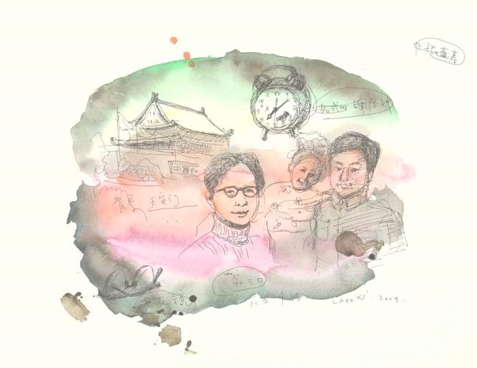
“One – child policy”, watercolour on paper, 31 x 41cm, 2009.
The watercolour is partly a study of details and colour for the oil painting but it is also a painting expressing thoughts and a mood. It is painted with Chinese ink, watercolour, pencil and brush. When Chen Xi paints a watercolour she often adds supplementary techniques and different equipment including large Chinese calligraphy brushes and ever strokes of oil paint. Chen Xi has a long habit of working in watercolour and she sees the medium as optimal for fluent work with colours.
The watercolour is a contemporary piece of art but it expresses a Chinese tradition.
A talk about the watercolours
PVN: I write to people who are engaged in in the technique of watercolour, and I like to discuss the role of watercolour in your work. Is the watercolour a step towards your final oil painting or is it a piece of independent art as well?
CX: The watercolours are made to prepare the themes I want to study. When I made a watercolour in this exhibition it has two functions: I want to confirm preliminary ideas and I want to study the emotional side of the situation. It is interesting for me that a watercolour may contain some unfinished phases and therefore it is open for more directions (A discussion of art between Chinese and English was difficult because some words cannot be translated.
One of the words that Chen Xi often used is 绘画性 (hui hua xing, the characteristic and nature of a drawing), and the interpreter in the interview, Kei Tung Talyta, struggled to translate that word. The most suitable translation online were 'painterliness' or maybe 'formal quality of painting').
Oil paintings and watercolours were displayed side by side in the museum as suggested by the curator and the museum in this case. Chen Xi agrees with the suggestion. Only one watercolour is made of every scene in the exhibition: So we remember.
PVN: All the watercolours on the exhibition are made before the oil paintings. Could you also have painted watercolours after a finished oil painting?
CX: It happens when I want to explore and enjoy the use of watercolour.
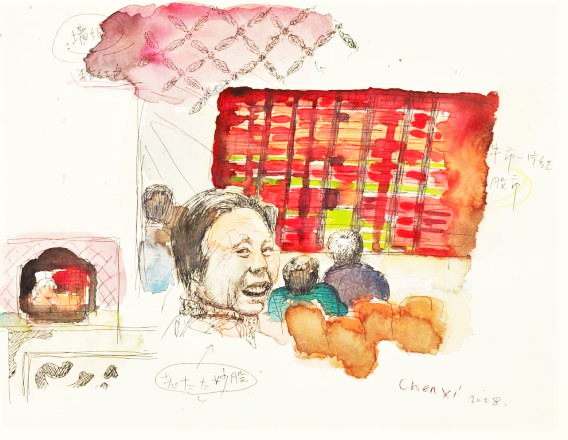
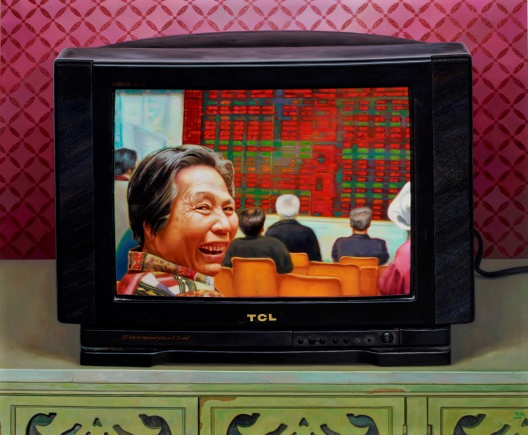
“Stock market”, watercolour on paper, 31 x 41 cm, 2008 and “Stock market”, oil on canvas, 150 x 180 cm, 2009.
PVN: “Stock market” is a big issue in China and you selected it as one of the important events in the flow of TV news to the Chinese people. Is the girl in the painting one of your friends?
CX: The girl is not one of my friends. With the painting I want to tell that all talks about the stock market! People are thinking too much about money. The watercolour in this set is partly a study of several details in the later oil painting and partly a fluent study of colour and mood.
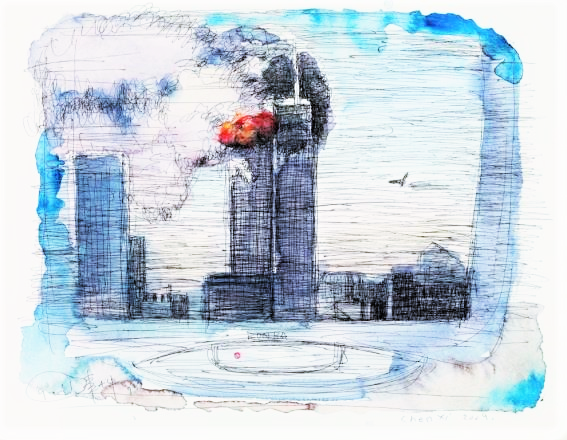
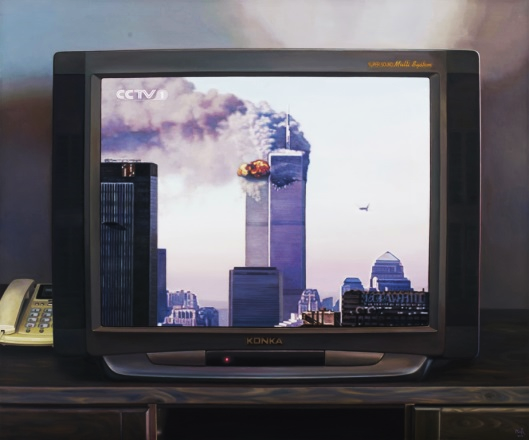
“9/11”, watercolour on paper, 31 x 41
cm, 2009 and
“9/11”, oil on canvas, 150 x 180 cm, 2009.
PVN: The 9/11 event is not a Chinese - but an international disaster. Your TV shot is in fact not a picture but a sequence because you show both the second aircraft in the air and the flames when it flows into the second tower a spilt second later. The watercolour is a strong depiction of the shock we all received.
CX: I really saw the image of this incident on the TV news on that day. The incident was incredible in a sense that everyone in the world could not believe what they have seen was real. I remembered that, during that few days, the TV news repeatedly broadcasted this incident with slightly different perspectives. Meanwhile, with the comprehensive news reports, we immediately noticed that two planes had crashed into the towers successively. But we did not see the full version. Therefore, I added a plane which was crashing into the tower on this mostly broadcasted TV news scene, in order to present a comprehensive process of the disaster. I decided to put this incident into my series after cautious consideration. I hesitated at first as it happened outside China. But I still used it because after the 9/11, shadow of terrorism gradually permeated the world. Its influences had already gone beyond national boundaries. It was not a disaster for a single nation, but a common challenge faced by the contemporary world.
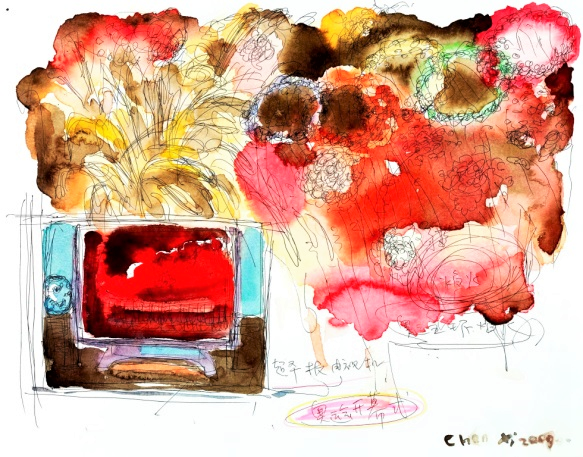
“Opening ceremony of the Olympic Games”,
watercolour on paper, 31 x 41 cm,
2009.
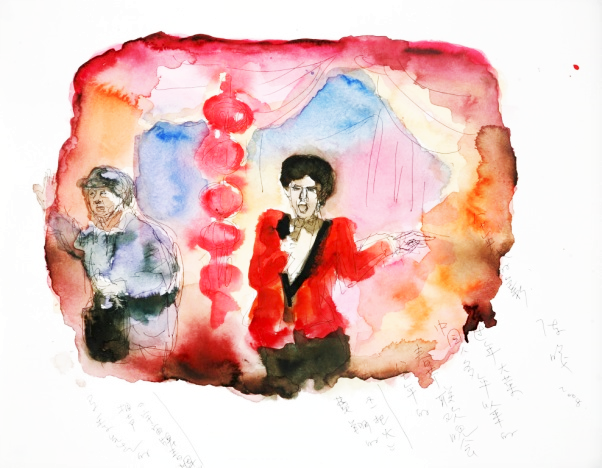
“Spring festival gala evening”,
watercolour, 31 x 41 cm, 2008.
PVN: You talk about working with the joy of colour when you use Chinese ink and watercolour. I found this in your two paintings: “Opening ceremony of the Olympic games” and “Spring festival gala evening”. You have painted 22 different themes covering events from the 1960’ties up to now and created a history for our present and future generation. Will you continue this exploration of the TV controlled history?
CX: Yes, I will continue this series as long as TV will continue the control and influence on ours memories!
Biography
Chen Xi is a professor at the Oil Painting department, Central Academy of Fine Arts in Beijing. She graduated at the Oil Painting Department, Central Academy of Fine Arts in 1991.
Literature
Chen Xi, Florian Knothe and Sarah Ng,
Chen Xi:
So We Remember, University Museum and Art Gallery,
The University
of Hong Kong, ISBN 978-988-19023-5-1, 2016.
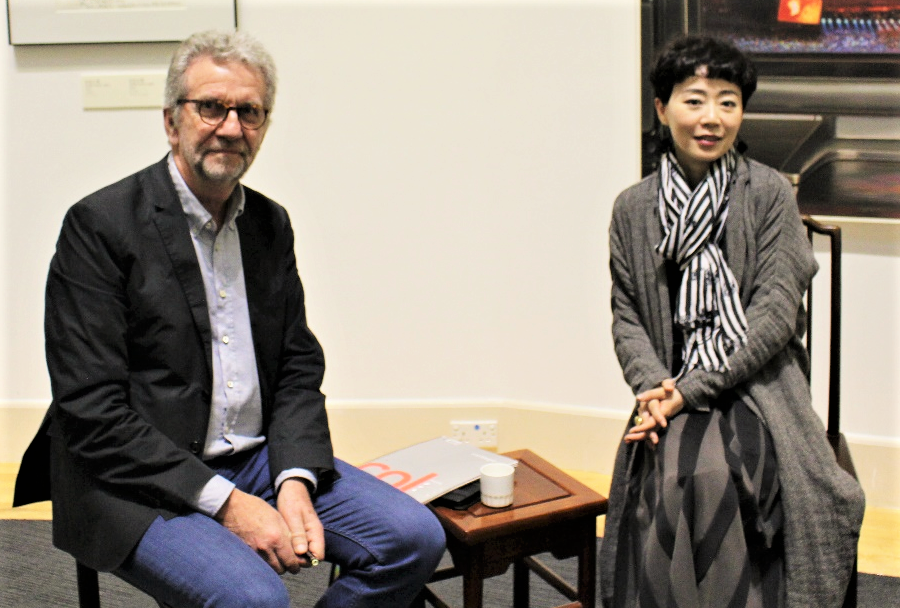
Chen Xi and Peter V. Nielsen